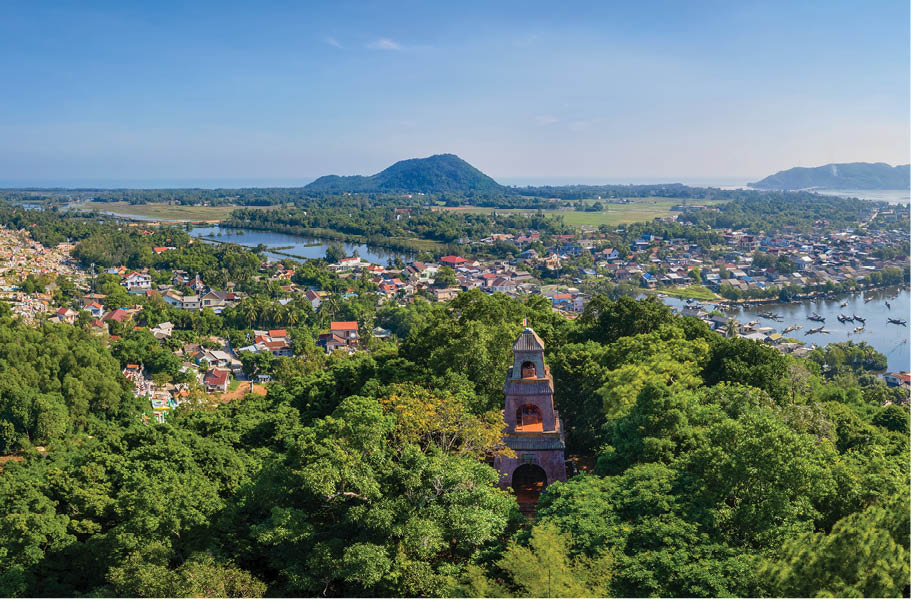In 1825, Emperor Minh Mang rebuilt the pagoda and completed the compound in more than 10 years, including a temple (Thanh Duyen), a pavilion (Dai Tu) and a tower (Dieu Ngu).

Contemplating Tu Hien estuary and Cau Hai lagoon is a recommended experience when visiting Hue. Photo: NGUYEN PHONG
Forty years ago while studying at high school, I had a friend who lived at Vinh Hien. In summers, we travelled to Tu Hien to visit him, swim in the sea and contemplate Tuy Van scenery. In the morning, we caught a bus to Da Bac, and waited there for maybe over an hour, then took a big boat passing Cau Hai lagoon.
It was approximately noon time when we arrived at Vinh Hien seaport. In the afternoon, we went swimming in the sea or hiking Mount Tuy Van. We woke up early in the next morning to go to the local morning market and got on the first boat back to Da Bac. That was the journey, in just a day and night, but sometimes in a few days.
Once in the summer of 1983, my friend took two Hanoian girls to his hometown. I was selected to escort the group. The two new friends passed the immense lagoon for the first time with curiosity and pleasant. Hence, they kept talking and chatting about it.
Reaching Tuy Van in the late afternoon, we climbed up 38 the steps to visit the pagoda, then went to Dai Tu Pavilion and stayed for a really long time on the top of Mount Tuy Van, where Dieu Ngu tower is located. The tower has a quadrilateral shape with 3 storeys of about 13 meters high.
In the old days, the top of the tower had a Wheel of Dhamma, which moved as blown by the breeze and placed on a bronze column, and a system of wind bells. When the wind blown, the Wheel of Dhamma revolved. The sound of the bells echoed everywhere.
High from the Dieu Ngu tower looking down, there exists an immense blue range of a coconut grove and green paddy fields embracing villages. When the afternoon gradually wears on, houses loom in the indigo smoke. Also from this view, a panoramic scenery of Tam Giang - Cau Hai lagoon, Tu Hien estuary and the Mount Bach Ma from the distance are displayed.
The immense water surface of Tam Giang - Cau Hai lagoon is like a mirror reflecting the blazing sun. Meanwhile, Bach Ma range looms like a water-colour painting that makes many travelers moved.
This just reminds me of the two touching verses of Emperor Minh Mang in his poem of “Len thap Dieu Ngu” (Climbing up the Dieu Ngu tower): Tu dien ha quan lam dai dia /Tam tang cao suc lap trung thien (tentatively translated as: This land is vast at all sides/Three steps rise up to the immense sky).
Legend has it that when Emperor Minh Mang rebuilt the pagoda, he ordered to built a monastery and a kitchen, and named them Thuy Hoa temple. The mount was hence called as Thuy Hoa.
The pagoda was then renamed Thanh Duyen meanwhile the mount still retained the old name until the reign of Emperor Thieu Tri. Due to the naming taboo regulation, the Emperor changed its name to Thuy Van because his mother's name was Ho Thi Hoa. Mount Thuy Van in association with blue waves of Cau Hai – Tu Hien lagoon created such a beautiful landscape that Emperor Thieu Tri ranked it the ninth among the landscapes of the Capital.
There is another story that a tipsy drunken person passed this mount and saw clouds setting off on its top. He thought that clouds were drunk. He then called the mount Tuy Van (drunken clouds). If you do not believe it, try once to climb Dieu Ngu tower to enjoy the landscape, blue clouds and water, and how the clouds are setting off the top of the mount. You may then experience the look of an emperor or simply the drunken clouds of a drunk.
Also, the road leading to Tuy Van for climbing up Dieu Ngu tower to enjoy the scenery of Tu Hien and Cau Hai is no longer separated and obstructed by the lagoon and boats. It has been much easier since Tu Hien and Truong Ha bridges were built over Tam Giang lagoon as well as the National Highway No.49 were upgraded. Yet, I still wish it to be separated and obstructed by the lagoon and boats to once return the boat trip that year to cross the immense Cau Hai lagoon.
By Dan Duy
